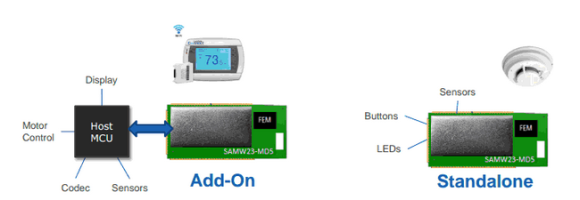This week we talked with Atmel about their new WiFi solutions targeting Internet of Things applications. Back in 2012, Atmel acquired Ozmo, a company focused on point-to-point WiFi solutions using WiFi Direct. These devices are known as SmartDirect, and have been available for some time.
Atmel has just announced a new product line: SmartConnect. This moves beyond the point-to-point nature of WiFi Direct, and enables connections to standard access points. The SmartConnect series is designed for embedding in low cost devices that need to connect to a network.
The first devices in the SmartConnect line will be modules based on two chips: an Atmel SAMD21 Cortex-M0+ microcontroller and an Ozmo 3000 WiFi System on Chip. There’s also an on-board antenna and RF shielding can. It’s a drop in WiFi module, which is certified by the FCC. You can hook up your microcontroller to this device over SPI, and have a fully certified design that supports WiFi.
There’s two ways to use the module. The first is as an add-on, which is similar to existing modules. A host microcontroller communicates with the module over SPI and utilizes its command set. The second method uses the module as a standalone device, with application code running on the internal SAMD21 microcontroller. Atmel has said that the standalone option will only be available on a case to case basis, but we’re hoping this opens up to everyone. If the Arduino toolchain could target this microcontroller, it could be a great development platform for cheap WiFi devices.

At first glance, this module looks very similar to other WiFi modules, including the CC3000 which we’ve discussed in the past. However there are some notable differences. One major feature is the built in support for TLS and HTTPS, which makes it easier to build devices with secure connections. This is critical when deploying devices that are connected over the internet.
Atmel is claiming improvements in power management as well. The module can run straight from a battery at 1.8 V to 3.3 V without external regulation, and has a deep sleep current of 5 nA. Obviously the operating power will be much higher, but this will greatly assist devices that sporadically connect to the internet. They also hinted at the pricing, saying the modules will come close to halving the current price of similar WiFi solutions. SmartConnect is targeting a launch date of June 15, so we hope to learn more this summer.
We’re always excited to see better connectivity solutions. If Atmel comes through with a device allowing for cheaper and more secure WiFi modules, it will be a great part for building Internet of Things devices. With a projected 50 billion IoT devices by 2020, we expect to see a lot of progress in this space from silicon companies trying to grab market share.















The CC300 is at $22.68 in single quantity and $13.29/1.2k on DigiKey…
Halving the price should bring the Atmel module to $11.34 and to $6.65/1.2k, respectively.
This is to compare with the cheapest Chinese RT5350F-based router modules that you can find at $7.50 in single quantity on AliBaba. Of course, not FCC/CE/RoHS, not really low-power, but you can put a full OpenWRT Linux on them.
Things (Internet of them) are getting interesting!
I’m not a fan of the buzz-word “Internet of Things” but I am a fan of low-power WiFi capable hardware — especially in an architecture that I’m already accustomed to using. I don’t need the Arduino support Eric mentioned. But I do need my “case” to fit in Atmel’s “case by case basis”. Just as you could directly program an Xbee’s onboard microcontroller this platform would be unbelievably convenient for remote parts of a larger system.
So yes, I wholeheartedly agree that this is getting really interesting!
WiFi is never really going to be a low-power technology, as far as being something that can run on a coin cell or other battery with limited current sourcing ability. However, for anything running off AA’s or chargeable lithium batteries, this is a very nice solution.
I think that is a bit optimistic I would expect it to be mid to high teens in single quantities. You should be comparing it to something like RN-171 or Murata SN8200.
Oh man, I have such high hopes that this will either blow the CC3000 and all its bugs out of the water or provide the much needed competition for them to get their act together.
Sounds great to me!
Looking forward to seeing the price details and modules that come out of this.
If consumer electronics devices get based on this, could make some very cool hackable hardware available!
Oh man, I hadn’t even thought of that. Wow… Not to be a naysayer but could we be so lucky? I suppose you’d run into the same trouble you do with available devices using known microcontrollers. They are code locked. Sure you can unlock but not without blanking the flash.
Until your neighbor hacks your stove to turn on at full power at night.
If I were to guess, the reason it is offered on a case by case basis is to insure that the wrong frequencies aren’t used. Different countries have different frequencies for WiFi and the FCC,, and their equivalents, get nervous that just anybody can access those illegal frequencies, So the case by case basis is probably so they have some assurances that only the legal frequencies are used.
In other words, don’t expect them to open up stand-alone mode.
AFAIK the channels have a fixed frequency in the 2.4 GHz band but several countries have special rules for some channels. The first 10 or so are free of these issues iirc.
Same for those RFM/Nordic/… RF modules, you can hop 2.4 GHz channels as you please.
I think this is more to do with NDA (+ development tools) and insurance against reverse engineering in case someone figures out how to bypass the lock fuses.
Is it just me or does this post seem to be a bit commercial? It reads like an Atmel promotional email and I don’t see that this IC is a great leap forward for hackers & makers. I love Hackaday. I hope I am wrong.
The post is pretty much the same as for the CC3000 when that came out. Or the electric imp. Were those ads? Maybe. But the more they post stuff from competitors the more I appreciate the info.
You are wrong. We don’t post paid content. The availability of cheap, drop-in WiFi is a game changer for small-run electronics which is why we wanted an early look at this offering.
Full disclosure: Atmel is one of our advertisers. But they did not approach us about this. I heard about this through Twitter and asked if they’d make an engineer available to talk about the new hardware and they obliged.
You can pick up old android smartphones on ebay for $10-20 bucks (LG Optimus S). They come with Wifi, bluetooth, mobile radio, lcd, accelerometer…etc. on board. Is there no way to interface these as add-on boards? Better yet, compile a custom kernel/rom for interfacing or as a stand alone, easily programmable system?
I see this like buying an old junky car because you wanted a stereo in your garage. Yes, that works but other smaller options may be better.
For instance, if you develop and awesome project and make it open hardware, anyone replicating the project on their own isn’t going to be happy if they need to source a particular deprecated smartphone in order to use the custom ROM.
Hopefully this truly does support TLS and HTTPS as the CC3000 doesn’t. For any IoT project that I work on I want to make sure that I do the best that I can to secure the communications.
hmm 2 months late and still not available.
And /still/ not available, as far as I can find… Anyone have chips in hand?
I can’t even find datasheets on this … WTF?